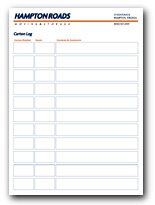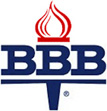|
|
Moving
Tips
We can provide you with expert packing
service. If you would rather pack yourself, here are some tips. We’ve organized
them into eight parts:
Your
Game Plan
Packing
Materials
Packing
Pointers
Packing
Dishware
Packing
Glasses and Stemware
Cars
and Motorcycles
Barbecue
Grills and Propane Tanks
For
Your Protection
Your
Game Plan
A little planning makes moving a
lot easier. Here is the beginning of a plan. Add specifics that suit your
needs and circumstances.
-
Plan to pack one
room at a time. Set aside a storage
area where you can stack cartons and keep the contents of each room together.
By keeping rooms separate, your unpacking will be more organized — and
easier.
-
 Pace
your packing.
Plan to pack a couple of cartons a day,
starting well ahead of the move. Pace
your packing.
Plan to pack a couple of cartons a day,
starting well ahead of the move.
-
Gather packing materials.
See
below for recommendations.
-
Keep a log.
Make
a carton identification log. List each carton for each room. Number the
cartons as you pack them, so that you will have a running total of the
cartons packed. Identify the contents of each carton in a few words; those
few words will help a lot when you find yourself asking “Where did I pack
the . . .” As appropriate, add comments about carton conditions or the
location of high-value goods. We’ve created a reproducible log for you.
You
can download it here.
-
Mark every box. Designate
the room and carton number. If the carton contains delicate, breakable
items, mark it FRAGILE.
Packing
Materials
Here is a list of packing supplies
that will come in handy:
-
Cartons. Use
only strong corrugated cartons with lids or covers. We can supply you with
specially made cartons for everything from mattresses to clothing and mirrors.
These cartons offer added protection that may prevent damage that results
from the use of poor-quality packing materials. Keep this in mind when
getting boxes from food stores.
-
Plastic Bags. Plastic
bags for small parts and labels for easy identification.
-
Filling Material.
Foam
peanuts, Styrofoam pellets, or “popcorn.”
-
Wrapping Paper. Tissue
or craft paper for delicate packing jobs. Corrugated paper rolls for figurines
and fragile items.
-
Tape or Twine. Gummed
tape (1 1/2 to 2 inches wide) and/or strong twine for sealing cartons.
Packing tape or gummed tape is better than masking tape.
-
Markers and Labels.
Markers
and labels for identifying contents of cartons.
-
Logbook. Notebook
and pencil for carton identification log.
Packing
Pointers
Golden Rule! Everything
that can fit in a box must be in a box; all boxes must have tops that are
sealed and firm when you push down on the top.
-
High-Value Items.
Notify
your mover of any high-value items.
You
can download our high-value declaration form here.
-
Carton Bottoms. Be
sure that the bottoms of all cartons are secured and will hold the weight
of the contents.
-
Heavy Items. Pack
heavier items toward the bottom of the box and lighter items toward the
top. Try to keep the weight of each box to 50 pounds or less; it makes
moving a lot easier. A general rule to remember on carton size: the heavier
the item, the smaller the carton.
-
Avoid Gaps. No
matter what you’re packing, assure a snug fit by using crumpled packing
paper between layers and wherever there’s a gap.
Packing
Dishware
 Use
this process on all saucers, bread-and-butter dishes, and other dishware. Use
this process on all saucers, bread-and-butter dishes, and other dishware.
-
Select a medium-sized carton (or mover-provided dishpack) and line the
bottom of the carton with crumpled packing paper.
-
Stack fresh packing paper neatly in place on a work table.
-
Center one plate on the paper.
-
Grasp two sheets of packing paper by a corner. Pull the sheets over the
plate by the corner until the sheets completely cover the plate.
-
Stack a second plate on the covered plate.
-
Moving clockwise, grasp a second corner and pull sheets over the second
plate.
-
Stack a third plate.
-
Fold two sheets of the third corner over the plate, and then two sheets
of the fourth corner.
-
Turn your wrapped stack of plates upside down onto your packing paper.
-
Re-wrap the entire bundle: start with one corner of packing paper and pull
two sheets over the bundle, cover bundle with next corner, then the third
corner; and finally, the fourth.
-
Seal the bundle with packing tape.
-
Place the bundle of dish-ware in a medium-size box so that the plates are
standing on edge.
When packing smaller dishes, you may choose to stack in greater quantity.
Packing
Glasses and Stemware
Delicate glassware and stemware should be placed in an upright position,
not on its side.
-
Stuff glasses and stemware with crumpled tissue or packing paper before
wrapping.
-
Lay a glass on the corner of a sheet of packing paper and roll it one or
two full rotations (depending on size).
-
Pull the sides of the packing paper up and over the glass and continue
rolling to the far corner.
-
If you wish, insert each glass in a corrugated paper roll or use a cellular
carton for added protection.
-
Place glasses and stemware toward the top of your carton. Place heavier
items (such as dishware or pitchers) toward the bottom of the box.
All boxes with delicate, breakable items, such as glasses and stemware,
should be marked FRAGILE.
Cars
and Motorcycles
Cars and motorcycles shipped on the moving van should be drained nearly
empty of fuel. Motorcycle batteries should be disconnected. Automobile
antifreeze should be ample to protect against severe cold in winter.
Barbecue
Grills and Propane Tanks
Wrap grates and briquettes separately in newspaper (or place all briquettes
into a grocery bag) and place parts in a carton. Pad the carton with paper
to reduce movement of the contents. Propane tanks cannot be put onto the
moving van.
For
Your Protection
The following information is very important. Please read it carefully.
-
Items Left Behind.
The
mover cannot be held responsible for items left at the residence after
loading. It is your responsibility to make sure that nothing is left behind.
Please make sure that you check your closets, cabinets, drawers, attic,
basement, garage, and outside areas before the driver leaves origin.
-
Valuables.
Do not ship bank bills, coins or currency, securities, deeds, notes, drafts,
valuable papers of any kind, jewelry, postage or revenue stamps, stamp
collections, precious stones, or precious metals. These items are not covered
by any insurance option.
-
Items in Drawers.
The only items to be left in any drawers or furniture are clothing. Do
not leave any loose items — such as pens, pencils, books, jewelry, or cosmetics
— in drawers.
-
Damage. It
is the responsibility of the shipper at the time of loading and delivery
to acknowledge in writing on the Bill of Lading or the “Household Goods
Inventory” any property damage to residence at origin or destination. Otherwise,
neither Hampton Roads Moving & Storage nor Paul Arpin Van Lines, Inc.
will be responsible for any damages.
|
|
|
ssisidebaramsa.html

Arpin Van Lines is certified as a PROMOVER by AMSA,
a non-profit trade association established in 1936.

[CLICK
TO LEARN MORE]
|
|
ssisidebararpin.html

As agents for Arpin Van lines,
we share a history of quality and service stretching back more than a hundred
years.
[CLICK
TO LEARN MORE]
|
|
ssisidebarmilitary.html

We are among the few movers
nationwide who meet the stringent qualifications of all branches of the
U. S. armed services.
[CLICK
TO LEARN MORE]
|
|
ssisidebarlpga.html

Arpin Van Lines is the official
mover of the Ladies Professional Golf Association.
[CLICK
TO LEARN MORE]
|
|
ssisidebarorgs.html

We are proud to belong to
the following organizations:
American Moving & Storage
Association
Better Business Bureau
Virginia Movers & Warehouseman's
Association
North Carolina Moving &
Storage Association
Virginia Trucking Association
Safety Council
Hampton Roads Chamber of
Commerce
National Defense Transportation
Association
[CLICK
TO LEARN MORE]
|
|
|
|
|
|

